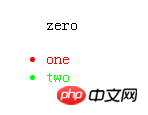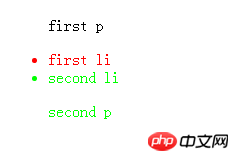Rumah >hujung hadapan web >tutorial css >CSS3中nth-child与nth-of-type的区别以及使用技巧
CSS3中nth-child与nth-of-type的区别以及使用技巧
- php中世界最好的语言asal
- 2018-03-22 11:27:462187semak imbas
这次给大家带来CSS3中nth-child与nth-of-type的区别以及使用技巧,使用nth-child与nth-of-type的注意事项有哪些,下面就是实战案例,一起来看一下。
CSS3中nth-child与nth-of-type的区别其实很简单::nth-of-type为什么要叫:nth-of-type?因为它是以"type"来区分的。也就是说:ele:nth-of-type(n)是指父元素下第n个ele元素, 而ele:nth-child(n)是指父元素下第n个元素且这个元素为ele,若不是,则选择失败。
文字未免听起来比较晦涩,便于理解,这里附上一个小例子:
<!DOCTYPE html>
<html lang="en">
<head>
<meta charset="UTF-8">
<title>demo</title>
</head>
<style>
.demo li:nth-child(2){
color: #ff0000;
}
.demo li:nth-of-type(2){
color: #00ff00;
}
</style>
<body>
<p>
<ul class="demo">
<p>zero</p>
<li>one</li>
<li>two</li>
</ul>
</p>
</body>
</html>
结果如下:

上面这个例子,.demo li:nth-child(2)选择的是
但是如果在nth-child和 nth-of-type前不指定标签呢?
.demo :nth-child(2){
color: #ff0000;
}
.demo :nth-of-type(2){
color: #00ff00;
}
这样又会是什么结果呢,看下html结构:
<ul class="demo"> <p>first p</p> <li>first li</li> <li>second li</li> <p>second p</p> </ul>
结果:

如上可见,在他们之前不指定标签类型,:nth-child(2) 选中依旧是第二个元素,无论它是什么标签。而 :nth-type-of(2) 选中了两个元素,分别是父级.demo中的第二个p标签和第二个li标签,由此可见,不指定标签类型时,:nth-type-of(2)会选中所有类型标签的第二个。
我们已经了解了nth-child和 nth-of-type的基本使用与区别,那么更进一步nth-of-type(n)与nth-child(n)中的n是什么呢?
nth-of-type(n)与nth-child(n)中的n可以是数字、关键词或公式。 数字:也就是上面例子的使用,就不做赘述。 关键词:Odd 、even
Odd 和 even 是可用于匹配下标是奇数或偶数的子元素的关键词
注意:第一个子元素的下标是 1
在这里,我们为奇数和偶数 p 元素指定两种不同的背景色:
p:nth-of-type(odd)
{
background:#ff0000;
}
p:nth-of-type(even)
{
background:#0000ff;
}
公式:或者说是算术表达式
使用公式 (an + b)。描述:表示周期的长度,n 是计数器(从 0 开始),b 是偏移值。
在这里,我们指定了下标是 3 的倍数的所有 p 元素的背景色:
p:nth-of-type(3n+0)
{
background:#ff0000;
}
相信看了本文案例你已经掌握了方法,更多精彩请关注php中文网其它相关文章!
推荐阅读:
Atas ialah kandungan terperinci CSS3中nth-child与nth-of-type的区别以及使用技巧. Untuk maklumat lanjut, sila ikut artikel berkaitan lain di laman web China PHP!

